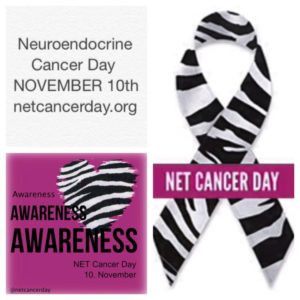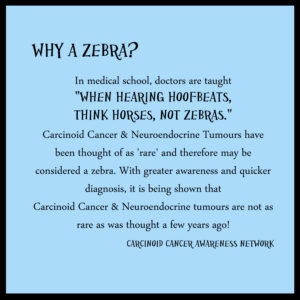Last week the world lost a music legend, Aretha Franklin. Many news organizations erroneously reported that she had passed away due to complications of pancreatic cancer. While Ms. Franklin was quite private about her health, she had spoken about her diagnosis on occasion. She actually did not have pancreatic cancer, but a neuroendocrine tumor in the pancreas. I see this a lot in the media – misreporting of a cancer diagnosis (but that’s a topic for another day). To the average person, this may not seem like a big difference. Both types of cancer were located in the pancreas, what’s the big deal? But there is a big difference between these two cancers – they are treated very differently, come with different concerns and cause different symptoms. Chances are you have never heard of a neuroendocrine tumor. During my time as a staff nurse, many moons ago, I hadn’t either. I’ve learned a lot since then…
In 1999, while training as a nurse practitioner, I spent 6 months working a few days a week with a well-known GI oncologist. In that time I met 2 people who had come to see this doctor for a second opinion on a recent diagnosis of pancreatic cancer. This doctor had been around the block and knew how to recognize the difference – these people had neuroendocrine tumors (NETs). A few tests that I had also never heard of confirmed his suspicion. Both had been diagnosed at reputable cancer centers, these people had done their due diligence, and yet they still received an incorrect diagnosis. This was my first introduction to NETs. Needless to say, it left a lasting impression. I searched online and found the Carcinoid Cancer Foundation, a support organization that offered lots of helpful information. Their list of specialists around the world was very telling– it was a very short list.
Flash forward a few years, and I met a woman named Nancy Lindholm O’Hagan who had been diagnosed with a NET at age 29. She had experienced what many people with NETs experience – a feeling of being alone on this journey. Out of her frustration she founded the Caring for Carcinoid Foundation in 2005, with the hopes of finding a cure. Nancy passed away from her cancer a few years later, but the organization continues on as the Neuroendocrine Tumor Research Foundation. Nancy’s passion was contagious and she encouraged me to learn more about these mysterious tumors.
Many NETs have no symptoms until they are quite advanced. Sadly, this results in a 5-year survival of 25-40%. Some people will experience vague symptoms such as abdominal pain, diarrhea and fatigue. Most people experience a significant delay in getting a diagnosis – an average 2-3 years of symptoms before reaching a diagnosis. One recent survey found a median of 9.2 years from symptoms to diagnosis among its respondents. People in this same study saw a mean 6.2 doctors before getting an accurate diagnosis. Many are given incorrect diagnoses of irritable bowel disease, dyspepsia, or dietary intolerances. Imagine how this affects your mental health – you know something isn’t right, but doctor after doctor dismisses your concerns.
Ms. Franklin’s NET was in her pancreas (as was Steve Job’s NET), but these tumors can occur virtually anywhere in the body. They most commonly occur in the GI system (bowel, pancreas, stomach, etc) and the lungs. The incidence of NETs has increased 5 fold in the last 30 years. This is mostly attributed to better diagnostic tests and improved awareness of the disease among healthcare providers – though there is a long way to go.
The good news is that there have been advances in treatments over the last 10 years. More research is happening, the Carcinoid Cancer Foundation’s list of specialists has grown, and there are more organizations serving this community and the specialists who treat these cancers. Cases in celebrities like Steve Jobs and Aretha Franklin give a chance for the public to learn more about these unknown cancers – but only if they are reported correctly. I hope this blog has helped you learn a little bit about these tumors. If you’d like to learn more (sure hope you do), follow some of the links below.
All About Carcinoid Tumors (a type of NET) on OncoLink
If you don’t suspect it, you can’t detect it! – A blog about NETs on OncoLink
The Carcinoid Cancer Foundation
Neuroendocrine Cancer Awareness Network
Neuroendocrine Tumor Research Foundation
Singh, S., Granberg, D., Wolin, E., Warner, R., Sissons, M., Kolarova, T., … & Leyden, J. (2016). Patient-reported burden of a neuroendocrine tumor (NET) diagnosis: results from the first global survey of patients with NETs. Journal of global oncology, 3(1), 43-53.
Carolyn Vachani is an oncology advanced practice nurse and the Managing Editor at OncoLink. She has worked in many areas of oncology including BMT, clinical research, radiation therapy and staff development. She serves as the project leader in the development and maintenance of the OncoLife Survivorship Care Plan and has a strong interest in oncology survivorship care. She enjoys discussing just about any cancer topic, as well as gardening, cooking and, of course, her sons.



Thank you so much for taking the time to share this information. I was dx 3 1/2 years ago. It has helped me so much that you and others take the time to share your knowledge.